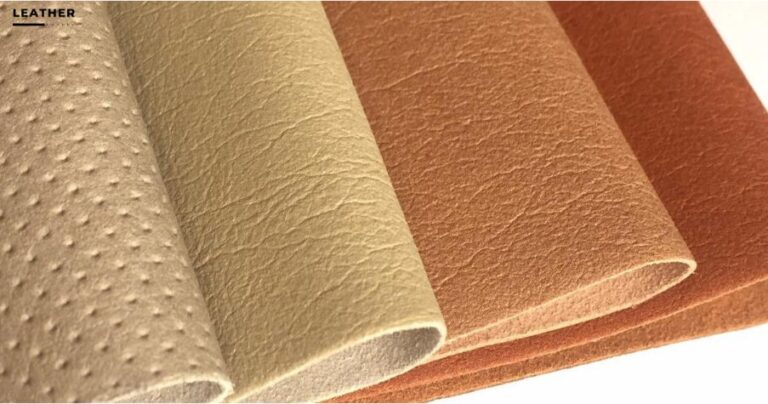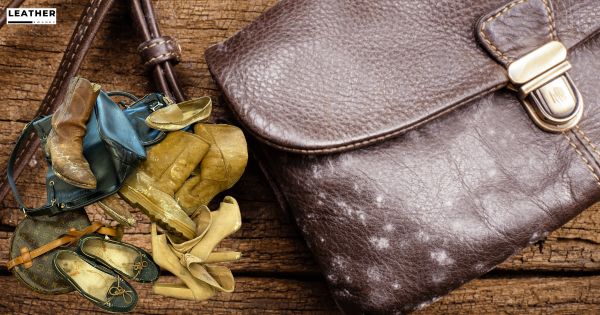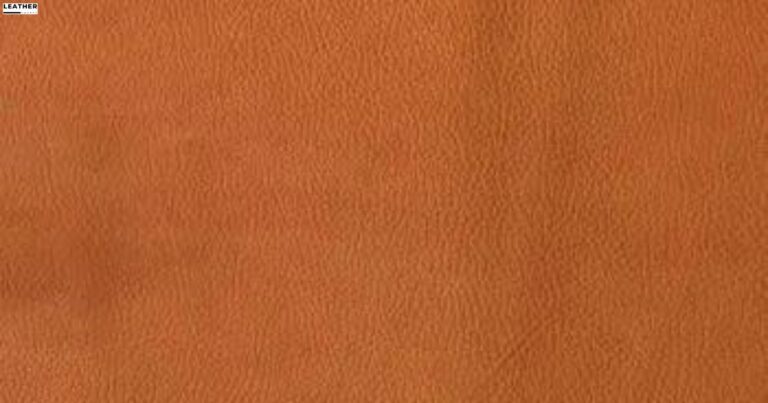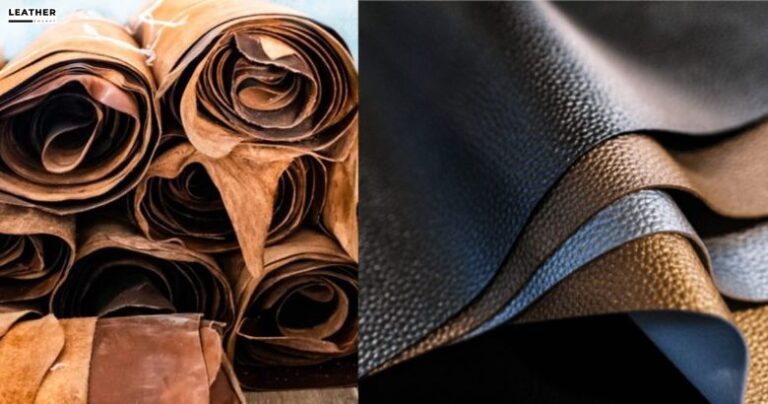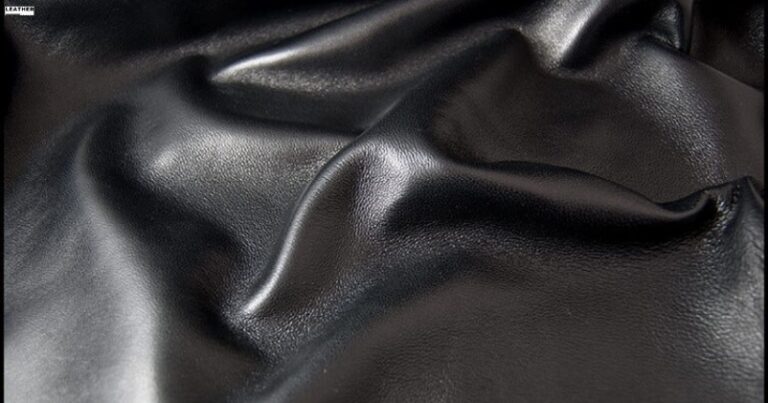How to Thin Leather? 6 Best Methods
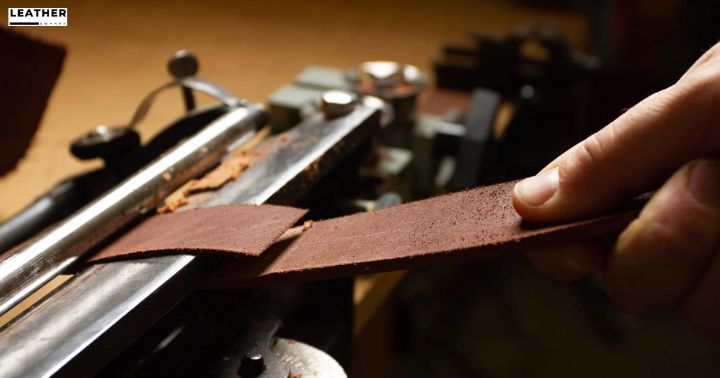
Do you need to thin out leather for a project? It can be tricky, but with the right tools and techniques, you’ll be able to do it with ease.
Thinning or skiving leather can be done with a special tool called a skiver, which is similar to a razor knife, use an exacto knife, use sandpaper blocks, use a kitchen knife and using french edger.
We’ll show you how to thin leather by using 6 different methods, or even a machine that can get the job done. We’ll also discuss the pros and cons of thinning leather
Jump to a Specific Section
- 1 Summary
- 2 Thinning Or Skiving Leather
- 3 1. Using The Exacto Knife To Thin Leather
- 4 2. Use Sandpaper Blocks To Thin Leather
- 5 3. Use a Kitchen Knife To Thin Leather
- 6 4. Using French Edger
- 7 5. Using Super Skiver
- 8 6. Using Safety Beveler
- 9 Skiving Leather Using a Machine
- 10 How to Thin Leather? Manual Versus Machine
- 11 Pros and Cons of Thin Leather
- 12 Final Verdict
- 13 Frequently Asked Questions
- 13.1 What Type of Leather Is Best for Thinning?
- 13.2 How Do I Know When I Have Thinned the Leather Enough?
- 13.3 Are There Any Health or Safety Risks Associated With Thinning Leather?
- 13.4 Can I Use a Heat Gun to Thin Leather?
- 13.5 How Do I Prevent Tearing or Fraying When Thinning Leather?
- 13.6 How can I sew thinner leather?
- 13.7 What should I do if the leather piece I have is too thick for my project?
- 13.8 What tools do I need to thin leather?
- 13.9 Is it possible to thin leather using a sewing machine?
- 13.10 Can I thin leather with a regular cutter or box cutter?
- 14 Resources Used for Research
Summary
- Tools and techniques for thinning leather include skivers, Exacto knives, kitchen knives, sandpaper blocks, French edgers, super skivers, Safety Bevelers, and Bell Knife Skiving Machines.
- Manual methods of thinning leather include skiving, sanding, splitting, beveling, and folding.
- Machine methods of thinning leather include leather splitting machines, belt sanders, leather skivers, leather embossing machines, and leather folding machines.
- Thinning leather offers pros such as adjustability, easier molding and shaping, suitability for custom-fitted items, better flexibility, and enhanced aesthetics, while cons include fragility if thinned too much, weakened structural integrity with excessive thinning, limited durability compared to thicker leather, reduced protection against impacts or abrasions, and limited applications for heavy-duty or high-stress use.
Thinning Or Skiving Leather
Thinning or skiving leather is a process of reducing the thickness of the material. It can be done with a special tool called a skiver, which is similar to a razor knife but has an adjustable blade.
Skiving leather takes patience and practice but once mastered it can open up all kinds of creative possibilities when crafting with this versatile material.
You can also use other methods which are:
1. Using The Exacto Knife To Thin Leather
Using an Exacto knife is one of the most effective ways to thin leather. It requires skill and a steady hand, but with practice, you can achieve impressive results.
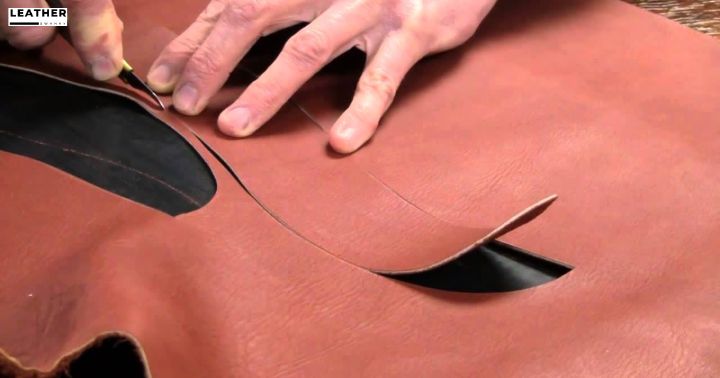
Here are some tips for thinning leather using an Exacto knife:
- Apply firm pressure while cutting in one direction only;
- Use multiple shallow cuts instead of trying to cut too deeply in one pass;
- Make sure you have a sharp blade, a dull blade will tear the leather, making it difficult to get even thickness.
a. How To Use An Exacto Knife To Thin Leather
Thinning leather with an Exacto knife is a straightforward task that requires the right tools and materials.
You’ll need:
- An exacto knife
- Cutting mat
- Contact cement
To get started, make sure your work area is clean and well-lit to ensure accuracy and precision during the thinning process. With these essentials in hand, you’re ready to begin.
Tools and Materials You’ll Need
You’ll need some specific tools and materials to thin leather:
- Sewing Machine: A standard sewing machine, or one with a skiving attachment.
- Blades: An exacto knife or skiving knife with a sharp blade.
- Materials: Leather of varying thickness. Having the right tools and materials makes the job easier, so make sure you have everything ready before beginning.
b. Tips For Thinning Leather with the Exacto Knife
When using an Exacto knife to thin leather, you’ll need to be careful.
| Tips | Advantages |
|---|---|
| Skiving Leather | Quicker |
| Using An Exacto Knife | Easier |
| Hand Skiver | More Precise |
| Rotary Cutter | Precision Control |
Using an exacto knife is a quick and easy way to thin leather. It’s best for large flat areas with short strokes so you don’t overwork the leather.
For greater precision, use a hand skiver or rotary cutter as these provide better control when skiving leather.
Careful attention should be given when using either tool, but it will allow for more precise cuts and thinner strips of leather than the exacto knife can achieve.
With the right tools and practice, you can easily achieve great results when thinning your leather.
2. Use Sandpaper Blocks To Thin Leather
Choosing the right sandpaper for your project is essential when thinning leather with a sandpaper block.
To make sure you have the best results, pick sandpapers with grits ranging from 80-220. You can easily make a sandpaper block by simply gluing sheets of sandpaper to a piece of wood or foam.
Once you have your block ready, use it in an up-and-down motion to begin thinning leather – making sure to monitor progress so you don’t overdo it.
a. How To Choose Sandpaper For Your Sanding Blocks
Choosing the right sandpaper for your sanding blocks can be a daunting task.
To make sure you get the best results, make sure to select a sandpaper with a base layer that is suitable for the material that you are working with.
Additionally, ensure that you pick the right grit size according to what kind of finish and texture you want to achieve.
Sandpaper Base Layer
To thin leather, start by sanding it with a fine-grit sandpaper. Be sure to use a sharp blade to ensure the surface of the leather is even and smooth.
Here are some tips for getting started:
Preparing the Sandpaper:
- Choose the right grit size
- Cut out your desired shape or size for your sanding block
- Apply an adhesive to one side of the paper
Applying Sandpaper to Your Sanding Block:
- Place paper on top of the adhesive
- Rub it in place with a cloth or sponge
- Trim off any excess sandpaper
Using these steps will help you achieve an even and consistent finish on your leather’s surface.
Grit Size
When deciding on the right grit size for your sandpaper, consider the desired finish and texture of the leather.
For leather craft projects, low-grit sandpaper is best for thinning out large areas of material.
If you need to skive a thin layer off or bevel an edge, use medium-grit sandpaper. To achieve a smooth surface, high-grit paper will be most effective.
For intricate detailing, extra fine paper may be necessary. A skiving machine can also help with precision when working with thicker layers of leather.
b. How To Make A Sandpaper Block
Making a sandpaper block is an easy process that requires just a few tools and materials.
You’ll need a solid surface, such as a scrap piece of wood or plywood, sandpaper, scissors, and glue.
To begin the process, cut the sandpaper to size so it fits snugly on the block. Then you’ll use the glue to attach it securely before using your new sanding tool.
Tools and Materials You’ll Need
You’ll need certain tools and materials to thin leather:
- For the leather work: a leather piece, thinner.
- For the sandpaper block: sandpaper, glue, and foam core board.
- For sewing leather: needle, thread, fabric scissors.
These are all important components of thinning your leather for any project.
c. How To Use Sandpaper Block To Thin Leather
To thin leather, use a sandpaper block and move it in a circular motion.
Start with the coarsest grit of sandpaper that is appropriate for the leather material you are using – typically 80-100 grit will work well.
Move the edge of the block around the surface of your leather project, taking care to avoid any paint or dye that may be present on your edges.
Sanding too deep or too quickly can damage your project – aim for a uniform thinning of 2mm over the entire piece.
If you need to achieve more than this, consider using multiple finer grades such as 150-220 grit for bookbinding projects or 3D carving projects.
Be sure to take short breaks between uses so that the sand does not build up on your edges and create an uneven finish.
With patience and practice, you can be sure to achieve even thinning throughout your project’s leather material.
3. Use a Kitchen Knife To Thin Leather
Thinning leather with a kitchen knife requires a light but steady hand. It is important to practice skiving leather by hand before attempting to use a kitchen knife to make the leather thinner.
Here are some tips for using a kitchen knife to thin down leather:
Preparing the Leather:
- Inspect the piece of leather for any unique features or areas that must be avoided when skiving.
- Take extra care not to cut into any stitching and check for any weak spots in the material.
- Mark out, if necessary, where you want to thin down the leather.
Using The Knife:
- Hold the blade of the kitchen knife at an angle that will allow it to slice off thin pieces of leather as you move along its surface.
- Push lightly and firmly with your free hand against the area being skived so that each pass removes more material from one side than the other.
- When you reach close to your marked-out area, reduce pressure on the blade until it just skimmed over the top of your markings without cutting them away completely.
When done properly, using a kitchen knife can help create precise and even thinner sections on the leather without having to use specialized tools like French Edgers or Skivers.
4. Using French Edger
You’ll need a few tools to use the French edger successfully. First, you’ll need a sharp knife or an X-Acto blade, a dull one won’t give you the crisp edges that French edging requires.
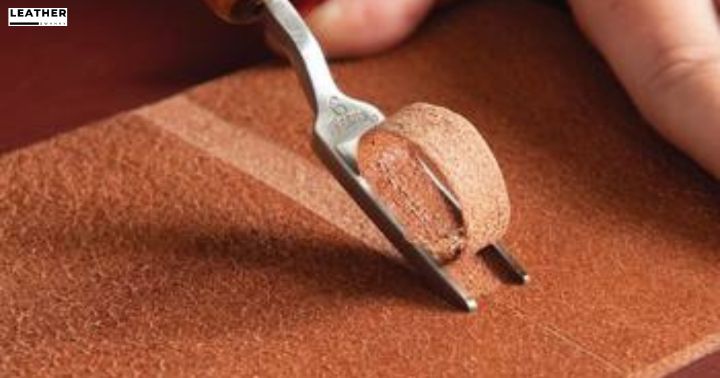
Apart from that, you’ll also need leather glue and waxed thread for stitching. Additionally, it’s important to have some scrap leather on hand to practice with before attempting it on the final piece.
Tools and Materials You’ll Need
Thin leather requires certain tools and materials, so you’ll need to have them on hand.
Here’s what you’ll need for a successful leather thinning project:
For prepping the piece of leather:
- A sharp cutter or splitter
- Leathercraft scissors
For thinning the leather:
- French edger tool
- Paring knife
To finish the piece:
- Leather stitching thread and needles
Gathering these items before getting started will ensure that your project goes smoothly.
5. Using Super Skiver
If you’re looking to thin leather with a tool like Super Skiver, you’ll need the right equipment.
Make sure to have an adjustable skiving knife, leather hole punch, work table, scissors, and a cutting board before getting started.
You’ll also need your leather of choice and any accessories you plan on using. With these materials in hand, you’ll be ready to begin thinning your leather with the Super Skiver.
Tools and Materials You’ll Need
To thin leather, you’ll need certain tools and materials. You will need a Cricut Leather Machine, upholstery leather or Nappa, adhesive for the material, and a safety beveled.
- A Cricut Leather Machine is necessary to create precise cuts in the material that would otherwise be impossible with traditional cutting methods.
- Upholstery leather or Nappa is usually best for thinning because it’s thicker than most other types of leather.
- The Adhesive is also important for keeping the material together while being worked on.
- Safety Beveler should also be used to ensure that no accidents happen while thinning the material.
Using these items correctly will allow you to achieve professional results when thinning your leather project.
6. Using Safety Beveler
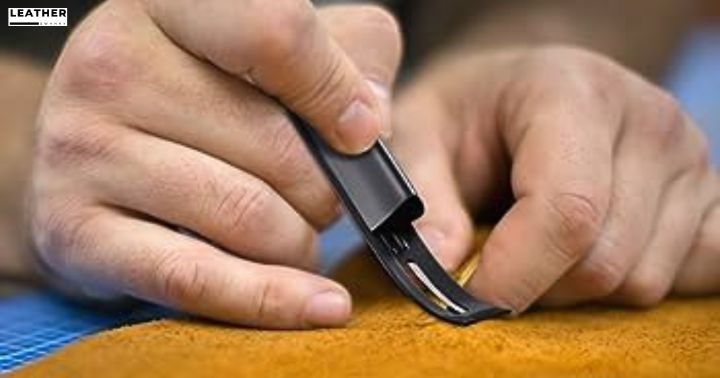
To get started, you’ll need a heavy-duty leather punch, an adjustable depth ruler, and a pair of safety gloves. Make sure you also have the correct type of leather for your project, thickness matters.
With all these components in place, you’re ready to start using the Safety Beveler to shape and thin your leather.
Tools and Materials You’ll Need
Thinning leather requires some specific tools and materials. Before you begin, you’ll need a few items:
- For stitch removal: a leather awl or punch, an X-acto knife, and a sharp pair of scissors.
- For thinning the leather: a beveler or skiver tool, and sandpaper in different grits (coarse to fine).
- To keep yourself safe: safety glasses, gloves, dust mask, and scrap leather for testing.
Skiving Leather Using a Machine
If you are looking to skive leather for your project, the use of a Bell Knife Skiving Machine can be an efficient and reliable method.
Understanding how the machine works and how to use it correctly is key in order to get the best results.
You need to familiarize yourself with the machine and its capabilities so that you can maximize its potential when skiving leather.
Understanding the Use of Bell Knife Skiving Machine
Using a bell knife skiving machine is a great way to thin leather. It’s an essential tool for making leather goods, straps, and other leatherworking projects.
When using a bell knife skiving machine, it’s important to understand all the components:
- Cutting board: A flat surface on which you place the leather for cutting.
- Protective cloth: A cover between the cutting board and the leather to prevent scratches or marks on the material.
- Bevel: An angled blade that cuts through layers of material quickly and evenly.
- Leather goods: The finished product was created with the help of a bell knife skiving machine.
Skilling with a bell knife is an art form that requires practice and patience; however, understanding how this type of machinery works will make your work more efficient and effective in creating beautiful leather pieces.
How to Use the Bell Knife Skiving Machine
To begin, place a piece of lambskin leather on the table. Then adjust the blade to your desired height and hold it in hand like a pencil.
Make sure it’s positioned so that you can glide it over the leather in one smooth stroke. When skiving, make sure that you don’t snag or tear the leather, instead, lightly shave off thin layers with each stroke until the desired thickness is achieved.
Finally, maintain an even pressure while skiving for consistent results.
How to Thin Leather? Manual Versus Machine
You’ve got two options for thinning leather – manual and machine.
Manual leather thinning
- Use a knife or skiving tool to cut away at the back of the leather in small, incremental amounts.
- Place the tool perpendicular to the top of the leather and slice away from it while keeping your strokes as horizontal as possible.
- Sharpen the knife often to make clean and precise cuts.
Machine leather thinning
- Understand how the machine works: the drive wheel rotates the blade, adjustable ledge holds up one side of the leather for an even cut.
- Make sure not to damage either side of the leather, especially if they have different finishes.
- Keep in mind which direction the tool is moving in relation to the top of the leather for consistent results.
Overall, manual and machine approaches both have their own pros and cons which will be discussed further in our next section about ‘Pros and Cons of Thin Leather’.
Pros and Cons of Thin Leather
Now that you understand the different ways to thin leather, it’s important to consider the pros and cons of doing so.
| Benefit | Drawback |
|---|---|
| Thinner leather is easier to mold and shape into desired forms. | Thinning out leather too much can cause it to become fragile and easily damaged. |
| Thinner leather is suitable for creating custom-fitted items. | Over-thinning can weaken the structural integrity of leather over time. |
Final Verdict
Thin leather is a great way to add style and texture to any project. Whether you choose to use an Exacto knife, sandpaper blocks, kitchen knife, French edger, or a machine, manual or automated thinning of leather can be done with ease.
However, it’s important to consider the pros and cons of thinning leather before starting your project.
By following these tips and tricks you’ll have no problem crafting beautiful pieces with thin leather that will last for years.
Frequently Asked Questions
What Type of Leather Is Best for Thinning?
You may want to use vegetable-tanned leather for thinning since it is more malleable and easy to work with. It can be shaped, carved, or molded easily while still maintaining its strength.
How Do I Know When I Have Thinned the Leather Enough?
You will know the leather has been thinned enough when it is soft and flexible to the touch, yet still offers support and durability. After use, check for any signs of wear or tear that may indicate it needs further thinning.
Are There Any Health or Safety Risks Associated With Thinning Leather?
Yes, there can be health or safety risks associated with thinning leather. Always use protective gear such as gloves and goggles to avoid contact with solvents and dust particles, which can cause respiratory irritation.
Can I Use a Heat Gun to Thin Leather?
Yes, you can use a heat gun to thin leather. Make sure to adjust the temperature so as not to damage the material and wear gloves and protective eyewear for safety.
How Do I Prevent Tearing or Fraying When Thinning Leather?
To prevent tearing or fraying, use a sharp knife or blade to carefully remove thin layers of leather. Make sure the blade you’re using is sharp and clean to get smooth results.
How can I sew thinner leather?
When sewing thinner leather, it’s important to use a smaller stitch length, as this helps to prevent the leather from tearing or stretching. It’s also advisable to use a leather needle, which is specifically designed for working with leather.
What should I do if the leather piece I have is too thick for my project?
If the leather piece you have is too thick for your project, you can thin it down by using a skiving knife. This tool allows you to remove layers of leather from the backside of the piece, gradually reducing its thickness.
What tools do I need to thin leather?
To thin leather, you may need the following tools: a skiving knife or sharp scalpel, sandpaper or sanding block, a splitting machine (for larger and thicker pieces), a sewing machine (optional), and leather edge paint to finish the edges.
Is it possible to thin leather using a sewing machine?
Yes, it is possible to thin leather using a sewing machine. Some sewing machines have a built-in leather skiving attachment, which helps to remove layers of leather from the edge as you sew.
Can I thin leather with a regular cutter or box cutter?
While it is possible to thin leather with a regular cutter or box cutter, it is not advisable as it can be difficult to achieve consistent thinness. Skiving knives or sharp scalpels are more suitable tools for this purpose.


